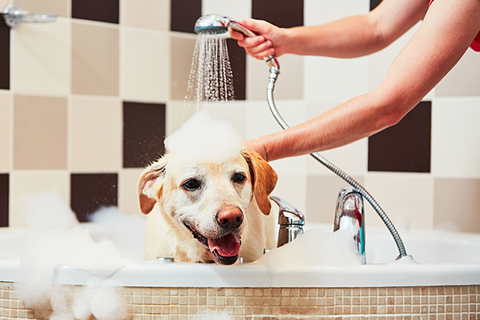
Pododermatitis in dogs
Pododermatitis is the veterinary term for inflammation of the skin on the feet or paws in dogs. It can be very sore, and cause ulceration and even lameness. Pododermatitis can have a variety of causes and can occur as a solitary symptom or as one part of a more generalised skin problem. Treatment usually depends on identifying the cause but can include topical treatments such as shampoos or medicated pads; as well as medication such as antibiotics or anti-inflammatories.
What does pododermatitis in dogs look like?
If your dog has developed inflamed feet, you may notice that their paws are itchy and irritated, and your dog may lick and chew at them excessively. The skin around and between the pads may be red and swollen, with areas of hair loss (alopecia). Sometimes, there may be areas of ulceration or small nodules which may be discharging fluid. The paws are often wet from constant licking or from infection. Pododermatitis can be painful, and your dog may be reluctant to let you look at their paws or may be lame when they walk.
What causes pododermatitis?
There are a variety of causes of pododermatitis in dogs.
Allergies
There are several types of allergies that can cause inflammation to the skin of the feet, including contact allergies (walking on something which causes a reaction), food allergies and atopic dermatitis. The paws are usually very red, itchy, and swollen.
Parasites
A mite called Demodex can cause pododermatitis, with symptoms including hair loss (alopecia), swelling, and painful sores which can bleed. Demodex mites are present on the skin of most dogs in small numbers, but in some dogs this population multiplies immensely and causes a problem. This is likely due to a genetic susceptibility, a problem with their immune system, or (especially in older dogs) as a result of an underlying medical condition.
Foreign bodies
Small objects, such as wood splinters, grass seeds, or thorns, can pierce and enter the paws, and their presence then triggers an inflammatory reaction. Often, dogs lick and chew excessively at the area, and there may be small lumps or nodules which may leak pus or bloody fluid.
Infections
Bacterial and fungal infections are a common part of pododermatitis. Signs include redness, swelling, painful lumps and moist discharge. Infections are often secondary to other problems, such as allergies or infection. Foreign bodies are an important cause, driving bacteria down into the deeper tissues; but yeast infections (especially Malasezia) can also be a significant problem.
Hormonal problems
Some hormonal conditions, such as hypothyroidism, or Cushing’s disease, can lead to pododermatitis. This is usually due to related changes to the immune system and slower cell replacement within the skin, leading to an increased sensitivity to local infections.
Tumours
Some types of cancer can cause pododermatitis, usually restricted to one foot. There may be nodules, or occasionally just discrete areas of ulceration. The nail beds can be affected, such as with squamous cell carcinoma.
Immune mediated disease
Pemphigus foliaceus, lupus, and vasculitis can all cause inflammatory problems in the feet. Signs may include areas of crusting and blisters – these are fragile, and break easily, potentially leading to ulceration. Thickened, dark areas of skin are also possible.
Conformational issues
Some dogs are prone to pododermatitis due to having splayed feet, which leads to weight being placed onto the soft, haired skin around the pads. This causes inflammation and sore, red areas of skin around the pads.
Dogs with hairy feet with short, bristly hairs (for example, many Spaniels) can lead to hair shafts being pushed through the hair follicles of the skin into the deeper tissues. Here they set up a “interdigital granuloma”, as the body responds to the keratin protein of the hair.
Which dog breeds get pododermatitis?
Pododermatitis can affect any dog, but some breeds will be predisposed due to their susceptibility to underlying causes.
- Allergies – Shar Pei, West Highland White Terrier, Golden Retriever, Boxer, Dalmatian, Lhasa Apso, Boston Terrier, Fox Terrier, Labrador Retriever and Shih Tzu
- Demodex mites – Shar Pei, Shih Tzu, West Highland White Terrier, Pug, Boxer and Border Terrier
- Conformational – large-breed, heavy set dogs with splayed paws such as Bulldogs or Shar Peis
- Hypothyroidism – Labrador Retriever, Golden Retriever, Boxer, Cocker Spaniel, Dachshund and Irish Setter
- Cushing’s – Staffordshire terrier, Boston terrier, Yorkshire Terrier, Poodle, Dachshund and Boxer
Treating pododermatitis in dogs
There are two components to treating pododermatitis.
In almost all cases, the underlying cause should be addressed
Most of the health conditions which lead to pododermatitis are relatively complex to manage, and require a multifactorial treatment plan, such as with canine allergies.
However, there are some that can be treated directly with medication such as antibiotics for deep bacterial infections, drugs to control hormone imbalances or treatments for mite infestations.
At the same time, the inflamed feet must be soothed
Depending on the severity of the pododermatitis, anti-inflammatory medication may be required. Pododermatitis is often managed topically, using shampoos such as DOUXO® S3 Calm. This soothing shampoo contains ingredients such as Ophytrium to strengthen the skin barrier, and the topical nature of shampoos mean that the calming ingredients are delivered directly to the inflamed areas.
Can you prevent pododermatitis in dogs?
It is impossible to prevent your dog from developing certain conditions, such as hypothyroidism or allergies. However, keeping your dog’s skin healthy, clean and strong is essential for maintaining a good skin barrier and reducing the likelihood of infections and inflammation. Keep your dog’s feet clean after muddy walks by using wipes or shampoo, inspect them regularly for any signs of redness, soreness, lumps or ulceration and seek veterinary attention if anything seems amiss.
Pododermatitis in dogs: key points
- Pododermatitis is the term for inflammation of the skin of the paws, but it can also include inflamamtion of the paw pads and even the nails and nail-beds.
- It causes red, sore, swollen feet, sometimes with nodules or lumps and discharge. Your dog’s feet may be moist, and they may lick and chew at them excessively.
- Underlying causes include allergies, parasites, infections, immune disorders, hormonal imbalances, poor conformation, foreign bodies or tumours.
- Treatment relies on managing the underlying cause, and often using topical shampoos such as DOUXO® S3 Calm to soothe the skin.
















